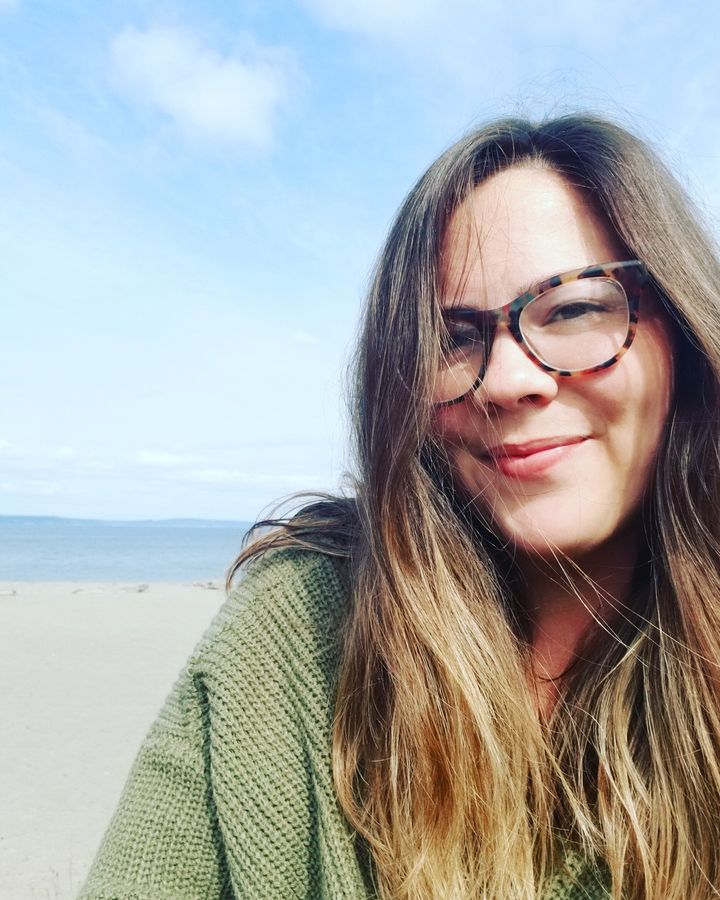
I became a yoga teacher because I wanted to be skinny.
After a breakup in 2011, I lost a bunch of weight on a diet that became an eating disorder and started practicing yoga.
One day at a yoga studio, I observed a group of size-2 yoga teachers, literally discussing love and light, and I thought, “that must be how they all stay so skinny.” They’re teaching yoga all day — doing lots of “vinyasas” and ab work. My body would never look like that sitting at a desk all day, merely attending yoga after work and on the weekends.
And thus, I began my journey to becoming a yoga teacher.
Don’t get me wrong; I liked yoga. After running the New York City marathon as a failed attempt at weight loss, the only thing I had to show for it was a knee injury. Prior to yoga, all exercise was punishment. Its sole purpose was to compensate for what I ate and shape my body into something more acceptable and desirable by societal standards.
I was sure that I hated my job and most other parts of my life because I wasn’t skinny. It was definitely the reason I didn’t have a boyfriend. If I shrank my body down to almost nothing, I would have the perfect life. That’s the diet culture promise: Lose weight and all is coming. That was my mantra, adapted from Ashtanga yoga founder Pattabhi Jois’ famous quote, “Practice and all is coming.”
I was deemed a yoga teacher after paying $3,000, showing up for 10 weeks, and being handed a piece of paper signed by another white yoga teacher under the age of 25. My job still sucked and there were no romantic prospects in sight. I blamed my circumstances on my body. I needed to be better at my eating disorder by doing more yoga and eating less.
“My yoga practice started as a means to punish my body for my life not being perfect.”
I couldn’t figure out the doing-more-yoga part while simultaneously paying rent in New York City, so after a year of puttering around, I moved to Houston, where my sister assured me the cost of living was much lower and new yoga studios were abundant.
In Houston, I managed to teach yoga full time and piece together a semi-livable salary. I wasn’t skinny enough, though. I figured that the way I was teaching yoga must be the reason.
When I was freelancing, bouncing around to different studios, I was so burned out from teaching six classes a day that the last thing I wanted to do afterward was take a yoga class. Even teaching over 20 classes a week, I was barely scraping by, so I took a job teaching yoga in a public elementary school. The job provided me a stable schedule, benefits and the promise of summers off.
I liked the school job, but I still didn’t have as much time to practice as I wanted. So I applied to be the director of a yoga studio. Part of the job was taking other teachers’ classes and offering them feedback. My eating disorder was excited about this idea: more time to exercise and lose the 15 pounds I had put on in the last few years from not practicing multiple times a day.
Unsurprisingly, the director job didn’t make me skinnier or happier. It was the worst of all. As the director of the studio, I was highly visible. I was expected to pack my classes full of people, appear effortlessly wise and inspire people to want to be like me. Quite a task when you have an eating disorder voice in your head saying you’re worthless, unlovable and that the reason people aren’t coming to your class is that you’re too fat.
Thanksgiving 2015, I was on the keto diet. I subsisted only on bacon-wrapped asparagus and cauliflower mashed potatoes. I peed on a pH strip every hour, making sure my body was still in ketosis. I was constipated and my skin was breaking out. I stepped on the scale the next day and had gained three pounds. I knew I couldn’t live like this anymore, and it was time to get professional help.
During my second session with my therapist, I burst into tears when I realized my entire career was built on an eating disorder. I made a living teaching people about an ancient spiritual practice while my own primary motivation was to shrink my body.
I slowly began to back away from teaching. I spent months grieving my eating disorder and the sense of false control and purpose it gave me in therapy. I learned about diet culture and its patriarchal influences. I learned about women using diets to distract themselves from doing meaningful work. Then came perhaps the scariest work of all ― if I wasn’t a yoga teacher and a dieter, what was I? Who was I? What did I even like to do if I wasn’t going to yoga or on a diet?
“During my second session with my therapist, I burst into tears when I realized my entire career was built on an eating disorder.”
During the grief process, I realized I wanted to be a therapist to help other people through their issues with food and body. When I moved to Seattle for graduate school, I knew I needed to take a step back from teaching yoga. I allowed myself time to reclaim my yoga practice. Eating disorder recovery helped me become attuned to my body’s needs around food. Now it was time to do that work with my relationship to yoga.
I practiced letting go of expectations about what my yoga practice should look like. I didn’t make up rules about how many classes per week I should take. I just went when I felt like it. I practiced trusting my body to tell me when it needed yoga. I still check in with myself about the intention behind my practice every time I roll out my mat. I ask myself: If I was 100% positive this movement would not shape my body or burn calories, would I still want to do it?
These days, I mostly practice at home in my living room. Occasionally, my body desires to practice in community and receive guidance from a teacher. Trusting my body is still an ongoing learning process, and I don’t do it perfectly all the time.
About a year into living in Seattle, a position became available to facilitate yoga therapy at the eating disorder treatment center where I work. Before I accepted another teaching job, I listened to my body for a few days. The idea of teaching yoga to individuals working toward recovery from eating disorders felt interesting and exciting. My body told me yes.
Even when my mind isn’t sure which way to go, my body helps me decide through present-moment felt sensations. I use this concept in yoga therapy all the time. We practice coming into the body by feeling sensations. These sensations hold information about what choices are best at the moment.
My yoga practice started as a means to punish my body for my life not being perfect. Now yoga is one of the primary ways I practice connecting to and trusting my body. My teacher once said that yoga is simply a tool, like a hammer. You can use a hammer to put a nail in the wall, or you can use it to hit someone over the head. Today, through recovery and therapy, I have finally learned to stop using yoga as a weapon.
Do you have a compelling personal story you’d like to see published on HuffPost? Find out what we’re looking for here and send us a pitch!
